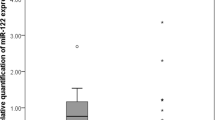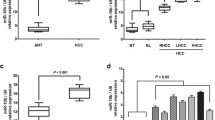Abstract
Hepatocellular carcinomas (HCC) are commonly diagnosed at an advanced stage with unresectable tumors. Although numerous non-surgical approaches have been developed to treat HCC, the prognosis of patients with HCC is still poor. This study investigated the expression of miR-149 and PARP-2 in HCC tumor tissues and their roles in sensitizing chemo/radiotherapy. The expression of miR-149 was measured by real-time PCR, and PARP-2 protein was measured by immunohistochemistry and Western blot. The xenograft HCC mouse model was established by inoculating Hep G2 cells. Increased PARP-1 and decreased miR-149 expression was observed in HCC tissues compared to peritumoral tissues. Positive PARP-2 and low miR-149 expression correlated with larger tumor mass size (P < 0.001), capsular and vascular invasion (P < 0.001), lymph node metastasis (P = 0.02), high histological grade (P < 0.001), TNM (P < 0.001), and BCLC grade (P = 0.001). The Kaplan-Meier survival analysis showed a negative correlation between high PARP-2 expression or low miR-149 expression in HCC tissues with the survival of patients. High PARP-2 and low miR-149 correlated with a low 5-year survival rate and are poor prognosis factors. Overexpression of miR-149 or inhibition of PARP-2 expression could inhibit tumor growth but was more effective in sensitizing chemotherapy and radiotherapy in xenograft HCC animal models. Increased PARP-2 expression and loss of miR-149 expression are involved in the pathogenesis of HCC and are poor prognosis factors in patients with HCC. Although both miR-149 overexpression and PARP-2 inhibitor exert some antitumoral effect, PARP-2 inhibitor is a chemo/radio sensor and can be used to enhance chemotherapy and radiotherapy in patients with HCC.



Similar content being viewed by others
References
Schlageter M, Terracciano LM, D'Angelo S, Sorrentino P. Histopathology of hepatocellular carcinoma. World J Gastroenterol. 2014;20:15955–64.
Chen WQ, Zheng RS, Zhang SW. Liver cancer incidence and mortality in China, 2009. Chin J Cancer. 2013;32:162–9.
Chen X, Liu HP, Li M, Qiao L. Advances in non-surgical management of primary liver cancer. World J Gastroenterol. 2014;20:16630–8.
Siegel R, Ma J, Zou Z, Jemal A. Cancer statistics, 2014. CA Cancer J Clin. 2014;64:9–29.
Yang N, Ekanem NR, Sakyi CA, Ray SD. Hepatocellular carcinoma and microRNA: New perspectives on therapeutics and diagnostics. Adv Drug Deliv Rev. 2014;81:62–74.
Guillot C, Favaudon V, Herceg Z, Sagne C, Sauvaigo S, Merle P, et al. PARP inhibition and the radiosensitizing effects of the PARP inhibitor ABT-888 in in vitro hepatocellular carcinoma models. BMC Cancer. 2014;14:603.
Yelamos J, Schreiber V, Dantzer F. Toward specific functions of poly(ADP-ribose) polymerase-2. Trends Mol Med. 2008;14:169–78.
Quiles-Perez R, Muñoz-Gámez JA, Ruiz-Extremera A, O'Valle F, Sanjuán-Nuñez L, Martín-Alvarez AB, et al. Inhibition of poly adenosine diphosphate-ribose polymerase decreases hepatocellular carcinoma growth by modulation of tumor-related gene expression. Hepatology. 2010;51:255–66.
Zhang B, Pan X, Cobb GP, Anderson TA. microRNAs as oncogenes and tumor suppressors. Dev Biol. 2007;302:1–12.
Calin GA, Sevignani C, Dumitru CD, Hyslop T, Noch E, Yendamuri S, et al. Human microRNA genes are frequently located at fragile sites and genomic regions involved in cancers. Proc Natl Acad Sci U S A. 2004;101:2999–3004.
Zhu Z, Zhang X, Wang G, Zheng H. Role of MicroRNAs in Hepatocellular Carcinoma. Hepat Mon. 2014;14:e18672.
Zhang Y, Guo X, Xiong L, Yu L, Li Z, Guo Q, et al. Comprehensive analysis of microRNA-regulated protein interaction network reveals the tumor suppressive role of microRNA-149 in human hepatocellular carcinoma via targeting AKT-mTOR pathway. Mol Cancer. 2014;13:253.
Mohamed JS, Hajira A, Pardo PS, Boriek AM. MicroRNA-149 inhibits PARP-2 and promotes mitochondrial biogenesis via SIRT-1/PGC-1α network in skeletal muscle. Diabetes. 2014;63:1546–59.
Zhang Y, Zhu X, Bai M, Zhang L, Xue L, Yi J. Maternal deprivation enhances behavioral vulnerability to stress associated with miR-504 expression in nucleus accumbens of rats. PLoS One. 2013;8:e69934.
Cohausz O, Althaus FR. Role of PARP-1 and PARP-2 in the expression of apoptosis-regulating genes in HeLa cells. Cell Biol Toxicol. 2009;25:379–91.
Brummelkamp TR, Bernards R, Agami R. A system for stable expression of short interfering RNAs in mammalian cells. Science. 2002;296:550–3.
Zhang G, Liu T, Chen YH, Chen Y, Xu M, Peng J, et al. Tissue Specific Cytotoxicity of Colon Cancer Cells Mediated by Nanoparticle-delivered Suicide Gene In vitro and In vivo. Clin Cancer Res. 2009;15:201–7.
Zhang X, Kon T, Wang H, Li F, Huang Q, Rabbani ZN, et al. Enhancement of hypoxia-induced tumor cell death in vitro and radiation therapy in vivo by use of small interfering RNA targeted to hypoxia-inducible factor-1alpha. Cancer Res. 2004;64:8139–42.
Prasad SC, Thraves PJ, Bhatia KG, Smulson ME, Dritschilo A. Enhanced poly(adenosine diphosphate ribose) polymerase activity and gene expression in Ewing's sarcoma cells. Cancer Res. 1990;50:38–43.
Tomoda T, Kurashige T, Moriki T, Yamamoto H, Fujimoto S, Taniguchi T. Enhanced expression of poly(ADP-ribose) synthetase gene in malignant lymphoma. Am J Hematol. 1991;37:223–7.
Nosho K, Yamamoto H, Mikami M, Taniguchi H, Takahashi T, Adachi Y, et al. Overexpression of poly(ADP-ribose) polymerase-1 (PARP-1) in the early stage of colorectal carcinogenesis. Eur J Cancer. 2006;42:2374–81.
Ossovskaya V, Koo IC, Kaldjian EP, Alvares C, Sherma BM. Upregulation of Poly(ADP-ribose) Polymerase-1 (PARP-1) in triple-Negative Breast Cancer and Other Primary human tumor types. Genes & Cancer. 2010;1:812–21.
Yelamos J, Farres J, Llacuna L, Ampurdanes C, Martin-Caballero J. PARP-1 and PARP-2: New players in tumour development. Am J Cancer Res. 2011;1:328–46.
Li D, Chen P, Li XY, Zhang LY, Xiong W, Zhou M, et al. Grade-specific expression profiles of miRNAs/mRNAs and docking study in human grade I-III astrocytomas. OMICS. 2011;15:673–82.
Luo Z, Zhang L, Li Z, Li X, Li G, Yu H, et al. An in silico analysis of dynamic changes in microRNA expression profiles in stepwise development of nasopharyngeal carcinoma. BMC Med Genom. 2012;5:3.
Wang Y, Zheng X, Zhang Z, Zhou J, Zhao G, Yang J, et al. MicroRNA-149 inhibits proliferation and cell cycle progression through the targeting of ZBTB2 in human gastric cancer. PLoS One. 2012;7:e41693.
Chan SH, Huang WC, Chang JW, Chang KJ, Kuo WH, Wang MY, et al. MicroRNA-149 targets GIT1 to suppress integrin signaling and breast cancer metastasis. Oncogene. 2014;33:4496–507.
Acknowledgment
This study was supported by the National Natural Science Foundation of China (81272972), National Basic Research Program of China (2010CB833605), Hunan Provincial Science and Technology Department (2014FJ4100, 3013FJ4010), Incubation Program for National Natural Science Funds for Distinguished Young Scholar of Central South University (2010QYZD006), Open-End Fund for the Valuable and Precision Instruments of Central South University.
Author information
Authors and Affiliations
Corresponding authors
Ethics declarations
Conflict of interest
All authors declared no conflict of interest.
Rights and permissions
About this article
Cite this article
Lin, L., Zhang, Yd., Chen, Zy. et al. The clinicopathological significance of miR-149 and PARP-2 in hepatocellular carcinoma and their roles in chemo/radiotherapy. Tumor Biol. 37, 12339–12346 (2016). https://doi.org/10.1007/s13277-016-5106-y
Received:
Accepted:
Published:
Issue Date:
DOI: https://doi.org/10.1007/s13277-016-5106-y




